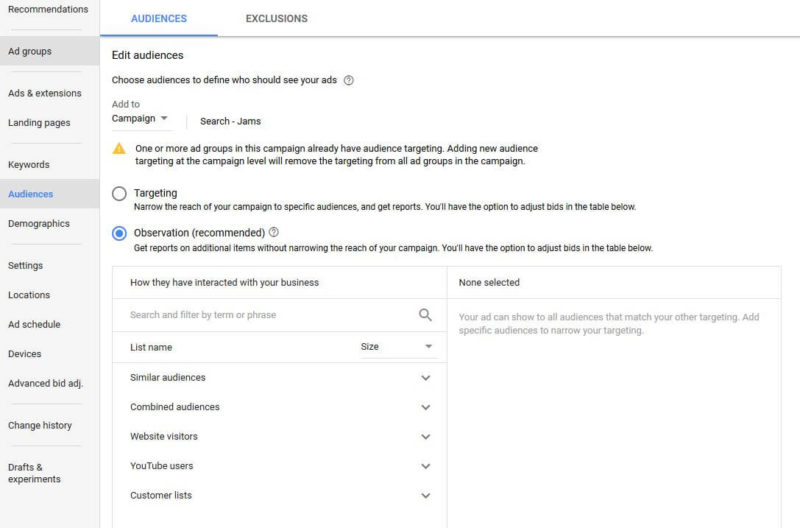Beyond keyword targeting in Search: location, device, audience and demographic
We’ve covered keyword and other targeting options in an earlier chapter of this guide, but there are several additional targeting levers available for PPC campaigns.
Location targeting
Advertisers can set campaigns to run in specific locations. Location bid modifiers allow you to increase or decrease the maximum CPC you’re willing to pay for clicks from target locations. It’s also possible to exclude locations within a target area.
Device targeting
It used to be common practice for advertisers to split out campaigns by device. This way they could control the budgets and tailor ads and landing pages by device. Then Google introduced bid modifiers, and there are now fewer use cases for separating campaigns by device. In Search campaigns, device targeting is managed entirely with bid adjustments.
Audience targeting
Audience targeting has continued to play a greater role in Search campaigns in the past few years. Ads can be targeted based on behavioral signals rather than just keyword intent signals (fig. 40).
Advertisers can import audiences from Google Analytics, upload customer emails and/or phone numbers with Customer Match, retarget those who’ve interacted with a linked YouTube channel, reach users whose recent browsing activity suggests they are In-Market for a product or service, and expand the universe of targeted users behavioral signals with Similar Audiences.
Targeting vs. observation
When you add an audience(s) to a campaign, you can opt to target just the people on that list by selecting “Targeting” — or you can choose “Observation.”
It’s common practice to add several, if not all, of your key audiences to a campaign under Observation. Observation allows you to gather data on how a particular audience performs while still allowing ads to show to searchers outside of the list.
Once you gather enough performance data on an audience, you may opt to target that audience in a separate campaign or decide to customize ad copy to an audience using IF Functions. You can also exclude audiences from a campaign.
Demographics
Reporting and targeting by age range, gender and household income percentiles are available in AdWords from Demographics in the left navigation (Fig. 41). But you’ll often see a higher percentage of data categorized as “Unknown” where Google doesn’t have enough information about the user.
Advertisers can exclude a demographic target from an ad group or set a bid or bid adjustment on any of them by checking the box next to them and editing. It’s also possible to analyze combinations of demographics: females in the top 10 percent of household income, for example.
Read more of The Search Engine Land Guide to PPC:
- Chapter 1: Where do paid search ads appear in the search results?
- Chapter 2: How the PPC ad auction works
- Chapter 3: What you’ll need before you get started setting up a PPC account and paid search campaign
- Chapter 4: Tracking and measurement for PPC campaigns
- Chapter 5: Setting up your paid search account
- Chapter 6: Introduction to Search campaign structure: Ad groups, keywords, ads and ad extensions
- Chapter 7: Setting up a paid search campaign
- Chapter 8: Beyond keyword targeting in Search: location, device, audience and demographic
- Chapter 9: Bidding and bid adjustments in paid search campaigns

